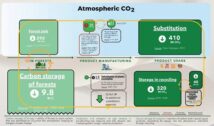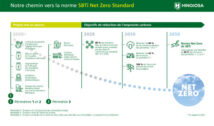
By 2040, the climate benefit contributed by the forest industry is set to increase by 30 per cent. For SCA – which is already strongly climate positive – this is a logical development that can also support the bottom line.
“Climate benefit created by our products is a major driver of increased future demand. As a company, we have a golden opportunity to help society replace products with a high fossil footprint through our business,” says Susanne Rutqvist, who heads up SCA’s climate initiatives.
SCAs is a strongly climate-positive company and in 2022 contributed a climate benefit of 10.1 million tonnes of carbon dioxide equivalents. This benefit is created through two equally strong factors: through net carbon storage in the company’s growing forests, and because products with a large negative fossil footprint can be replaced by products made from or based on biomass from the forest.
The industry organisation Swedish Forest Industries, in wich SCA and around 200 other companies are members, has decided to jointly increase the forest industry’s positive climate benefit by 30 per cent by 2040.
“It’s an ambitious, but realistic, goal for an industry that is inherently climate-beneficial and is based on the efficient use of a renewable raw material. As Europe’s largest private forest owner, it’s only natural that SCA plays a key role in delivering on this promise,” says Rutqvist.
The path to that goal takes us through three main areas. The first stage is about developing and growing our forest holding and thereby create increase the rate of carbon sequestration in the forests.
Next, we need to increase what tends to be referred to as the “substitution benefit” and can be described as the positive climate effect that is created when concrete is replaced with wood in construction, plastic packaging is replaced by paper packaging, and fossil fuels are phased out in favour of biofuels.
SCA has already strengthened its future opportunities in these with aggressive investment that increases the capacity of sawmills, pulp mills and kraftliner factories.
“We’re working to increasing our capacity to make climate-smart products, and then our ability to contribute climate benefits will also grow. Because these products are renewable, there is a clear connection between increased production and growing climate benefits,” Rutqvist argues.
Lastly, in order to make an even greater positive contribution to climate benefit, we need to systematically work to reduce fossil emissions in the value chain. SCA has come a long way in industrial processes and in many cases has virtually fossil-free production.
The combined negative impact from fossil emissions is approximately 0.7 million tonnes carbon dioxide.
“This mainly relates to transport, and there’s a relatively major challenge associated with that which we, our industry, and the rest of society will have to address together. Technological development is fast, but it’s also about creating a social infrastructure that makes it easier to transform vehicles. This will require broad-based co-operation over a number of years,” says Rutqvist.

































